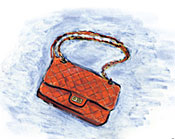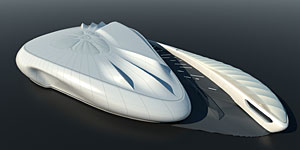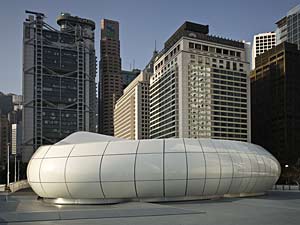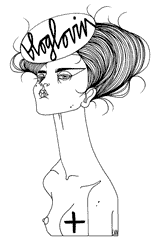Yet Another Design from Zaha Hadid
Wednesday, March 19, 2008
Hadid Bags Fashionable Chanel Project
 |
In a project that fuses fashion, art, and architecture, Zaha Hadid has created a moveable art space for the fashion house Chanel. Taking his cues from Mademoiselle Chanel herself—who supported Picasso, Jean Cocteau, Jacques Lipchitz, and other artists during her lifetime—Karl Lagerfeld, the company’s director of collections and ready-to-wear, gathered 20 international artists to collaborate with Chanel on unique art installations for the gallery. Officially opened yesterday in Hong Kong, the Mobile Art Pavilion, which resembles a space capsule, will touch down for one to two months at a time over the next two years in Tokyo, London, Moscow, and Paris, landing in New York City this September.
Lagerfeld chose Hadid’s architecture for what he describes as its poetry and innovation. The London-based designer, in turn, was drawn to the symbolism held by one of Chanel’s signature creations. “The quilted bag as Chanel’s inspiration for an exhibition that travels throughout the world is extremely interesting,” she explains. “Chanel’s fashion is similarly a global entity that has had such a worldwide presence.”
Hadid’s design will be put to the test as her curvy itinerant gallery travels across three continents. While the pavilion’s form follows the parametric distortion of a torus—a doughnut-like shape created by rotating a circle around another one in a coplanar axis—the intricate building elements needed to be small and lightweight enough to pack into standard sea containers, as well as easily reconfigured for assembly in a minimum amount of time. No structural element is wider than 7.38 feet. A polar grid cuts the distorted torus into 10-degree slices, defining the joint lines of its facade and creating a spatial rhythm of perspective views inside. Its cladding is made from fiber-reinforced plastic, a strong, lightweight material that can be molded into complex contours. Hadid’s fluid geometries define the interior. At the center of the pavilion is a 700-square-foot, curvilinear courtyard that allows visitors to see each other moving through the other spaces.

"This is not a museum space but an exhibition landscape,” says curator Fabrice Bousteau, who conceived of the eight-sequence exhibition as a three-dimensional movie. “Zaha Hadid’s architecture is very restrictive because it is original, but the restrictions imposed on the space worked in favor of the artists’ creativity—most of the works were created in reaction to it.”
Some of those artists include the photographer Stephen Shore, painter Michael Lin, and the conceptual artist Wim Delvoye. At the end of the exhibition sequence is Yoko Ono’s Wish Tree, which invites visitors to write a wish on a piece of rice paper and to tie it to the branches of a tree. When the pavilion’s tour concludes, wishes will be collected and sent to Ono’s Imagine Peace Tower in Reykjavík, Iceland.

Images courtesy Chanel (top, middle); Photo © Virgile Simon Bertrand (above).
A Chanel handbag, such as this one drawn by the company’s creative director, Karl Lagerfeld (top), provided inspiration for Zaha Hadid’s Mobile Art Pavilion (middle). The building takes the form of a torus (above).
--source from Architectural Record online
(http://archrecord.construction.com)
--ang tindi mo talaga, Zaha Hadid... may ganung factor! hahahaha







21 comments